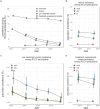This is a preprint.
Population dynamics of HIV drug resistance during treatment scale-up in Uganda: a population-based longitudinal study
- PMID: 39417110
- PMCID: PMC11482865
- DOI: 10.1101/2023.10.14.23297021
Population dynamics of HIV drug resistance during treatment scale-up in Uganda: a population-based longitudinal study
Abstract
Background: Clinical studies have reported rising pre-treatment HIV drug resistance during antiretroviral treatment (ART) scale-up in Africa, but representative data are limited. We estimated population-level drug resistance trends during ART expansion in Uganda.
Methods: We analyzed data from the population-based open Rakai Community Cohort Study conducted at agrarian, trading, and fishing communities in southern Uganda between 2012 and 2019. Consenting participants aged 15-49 were HIV tested and completed questionnaires. Persons living with HIV (PLHIV) provided samples for viral load quantification and virus deep-sequencing. Sequence data were used to predict resistance. Population prevalence of class-specific resistance and resistance-conferring substitutions were estimated using robust log-Poisson regression.
Findings: Data from 93,622 participant-visits, including 4,702 deep-sequencing measurements, showed that the prevalence of NNRTI resistance among pre-treatment viremic PLHIV doubled between 2012 and 2017 (PR:1.98, 95%CI:1.34-2.91), rising to 9.61% (7.27-12.7%). The overall population prevalence of pre-treatment viremic NNRTI and NRTI resistance among all participants decreased during the same period, reaching 0.25% (0.18% - 0.33%) and 0.05% (0.02% - 0.10%), respectively (p-values for trend = 0.00015, 0.002), coincident with increasing treatment coverage and viral suppression. By the final survey, population prevalence of resistance contributed by treatment-experienced PLHIV exceeded that from pre-treatment PLHIV, with NNRTI resistance at 0.54% (0.44%-0.66%) and NRTI resistance at 0.42% (0.33%-0.53%). Overall, NNRTI and NRTI resistance was predominantly attributable to rtK103N and rtM184V. While 10.52% (7.97%-13.87%) and 9.95% (6.41%-15.43%) of viremic pre-treatment and treatment-experienced PLHIV harbored the inT97A mutation, no major dolutegravir resistance mutations were observed.
Interpretation: Despite rising NNRTI resistance among pre-treatment PLHIV, overall population prevalence of pre-treatment resistance decreased due to treatment uptake. Most NNRTI and NRTI resistance is now contributed by treatment-experienced PLHIV. The high prevalence of mutations conferring resistance to components of current first-line ART regimens among PLHIV with viremia is potentially concerning.
Conflict of interest statement
Declaration of interests We declare no competing interests.
Figures




References
-
- HIV Drug Resistance Report 2021. Geneva: World Health Organization, 2021.
-
- UNAIDS. AIDSinfo. https://aidsinfo.unaids.org.
-
- Carr A, Mackie NE, Paredes R, Ruxrungtham K. HIV drug resistance in the era of contemporary antiretroviral therapy: A clinical perspective. Antivir Ther 2023; 28: 13596535231201162. - PubMed
Publication types
Grants and funding
- D43 TW009578/TW/FIC NIH HHS/United States
- U01 AI100031/AI/NIAID NIH HHS/United States
- R01 HD050180/HD/NICHD NIH HHS/United States
- ZIA AI001040/ImNIH/Intramural NIH HHS/United States
- U01 AI075115/AI/NIAID NIH HHS/United States
- K25 AI114461/AI/NIAID NIH HHS/United States
- R01 AI155080/AI/NIAID NIH HHS/United States
- R01 HL152813/HL/NHLBI NIH HHS/United States
- R01 HD091003/HD/NICHD NIH HHS/United States
- D43 TW010557/TW/FIC NIH HHS/United States
- R01 AI114438/AI/NIAID NIH HHS/United States
- P30 AI094189/AI/NIAID NIH HHS/United States
- R21 AI145682/AI/NIAID NIH HHS/United States
- R01 AI123002/AI/NIAID NIH HHS/United States
- K01 AI125086/AI/NIAID NIH HHS/United States
- R01 AI143333/AI/NIAID NIH HHS/United States
- R01 AI087409/AI/NIAID NIH HHS/United States
- R01 HD070769/HD/NICHD NIH HHS/United States
- R01 AI128779/AI/NIAID NIH HHS/United States
- R01 AI110324/AI/NIAID NIH HHS/United States
LinkOut - more resources
Full Text Sources
Research Materials
